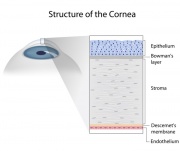Contents |
Epithelial Basement Membrane Dystrophy
Introduction
A corneal dystrophy is a non-infectious, non-inflammatory breakdown or deterioration of one or more of the five layers of the cornea, the clear, dome-shaped structure covering the front of the eye. The cornea is the first surface that light passes through on its way to the retina, so maintaining its smoothness and the regularity of its tissues is necessary for clear, undistorted vision. The outermost layer of tissue is the epithelium, a type of modified skin cell, which is attached to the next layer, the basement membrane. The basement membrane is also known as Bowman’s membrane or Bowman’s layer. (See illustration below.)
There are several corneal dystrophies, but by far the most common is "epithelial basement membrane dystrophy (EBMD), also known as map-dot-fingerprint dystrophy," because of its characteristic appearance in the biomicroscope, an optical instrument used by eyecare practitioners to evaluate the front parts of the eye. In the biomicroscope, it appears as an irregular pattern of cysts, ridges and circular whorls that resemble a map or a fingerprint.
It is not fully understood why certain corneas become dystrophic, but some have strong hereditary inclinations, are usually bilateral and that can be progressive. EBMD generally occurs after the age of 40, but can appear as late as age 70.
Symptoms
In EBMD, the basement membrane becomes thickened and irregular, causing the epithelium to buckle, wrinkle and break apart, so that the cells are easily dislodged from the surface of the cornea. The epithelium cells can break away and slough off, triggering symptoms of light sensitivity, blurred vision and discomfort. Patients with EBMD may also experience redness and irritation, ranging from mild to rather severe pain.
Because the eye does not blink and lubricate itself during sleep, symptoms are usually worse at the start of the day, improving somewhat as the day passes. In this aspect, EBMD is similar to "recurrent corneal erosion," a condition usually associated with improper healing after sustaining a corneal abrasion or injury.
EBMD is usually not progressive, but can be extremely variable in the way it affects the vision, and fluctuates over time. It can show up in just one eye, although it is usually bilateral. It can also be very asymmetric, effecting one eye more than the other.
Treatment
The first course of action is to augment the natural lubrication of the eye, using artificial tears during the day and ointments or gel lubricants at night. (This is because thicker lubrication modalities blur vision.) Hypertonic saline solutions, which contain more salt than normal tears, are also useful; lubricants are usually recommended on a regular schedule throughout the day as well.
In more severe cases, patients may need to use a soft contact lens as a bandage to protect the epithelium. Increasing humidity in the home using vaporizers or similar equipment may be recommended.
More permanent treatments include puncturing the corneal epithelium to allow better adherence of the epithelial cells, corneal scraping to remove eroded areas and allow regeneration of healthy epithelial tissue. Sometimes, the excimer laser may be used to remove surface irregularities.
Summing Up
Most cases of EBMD are easily managed and patients remain comfortable and abrasion-free. It is important, however, for patients with any type of corneal irregularities or dystrophies to be diligent in using the proper lubricants and to stay in close contact with their eyecare practitioner. By doing so, loss of epithelial cells can be kept to a minimum or prevented, which helps decrease symptoms and discomfort associated with EBMD.






